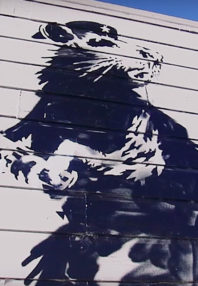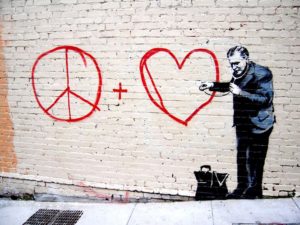
An important component of art is its context. A concept that I first thought concerned history or what that object would say about the culture it came from. But I’ve heard the interviewees in Saving Banksy use that word differently, denoting where art belongs. Most art under the possession of collectors or museums belong to defunct cultures.
That said, there are many artworks that are the centre to many tugs of war. Most of these fights are between a country where they originate and a collector or institution, benevolent or otherwise. This has been a problem for decades, if not centuries. And street art, the new movement in the art world, inherits that problem.
Before we talk about the problems that street art are facing, let’s talk about what it is first. It came from the youth culture of the past three decades. Its artists evolving from punks tagging walls to real artists making advanced works that bureaucrats can’t differentiate from tags.
The interviewees in Colin Day’s documentary Saving Banksy are smart. Artists like Banksy’s friend Ben Eine who speaks lovingly about the art. He also denotes the aesthetic qualities between his work. He also talks about the artists from all over the world working within the movement. But mostly Day’s footage makes the art’s value speak for itself.
Another problem street art faces is that bureaucrats whitewash and therefore deface it. The old guard fought over ancient artifacts. Now two schools of thought emerge, battling over how to preserve street art. Neither compensate the people making these pieces.
Saving Banksy concentrates on the phase of the artist when he was in San Francisco. He incorporated his tags with both the buildings and the city’s natural environment. Many of these works fell victim to amateur taggers. Day joins Brian Greif, an art collector, in a city tour of where Banksy’s works were. He wants to save at least one of these works.
Greif, the film’s de facto protagonist who thinks the piece belongs to a museum, has many hurdles. One is the city that wants to paint over Banksy’s piece. There’s the management of the buildings where Banksy painted. There’s the wall itself with a hundred years’ worth of paint that his crew contend with carefully.
These hurdles are nothing compared to Stephan Keszler, who Enie calls a ‘shyster’ and a ‘villain’. And this is a rare case when a documentary fills that role finding a figure with an ill-fitting suit. He has bad posture, pedantic speeches. He also has an obvious desire to make money out of a work without compensating Banksy for it.
The film entertains ideas from both camps. It also entertains a third idea, back to the idea of context, that street art belongs to the street. And that the only way to preserve it is through our memory. It’s intellectually dense for a film that’s way too short.
- Release Date: 3/3/2017

